Papers by Mariana Barboza
Animal study (C57BL/6J background transgenic mice) to determine the involvement of the superior m... more Animal study (C57BL/6J background transgenic mice) to determine the involvement of the superior mesenteric ganglion in the cholinergic anti-inflammatory pathway using optogenetic activation or blockade.
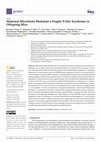
Genes
Maternal microbial dysbiosis has been implicated in adverse postnatal health conditions in offspr... more Maternal microbial dysbiosis has been implicated in adverse postnatal health conditions in offspring, such as obesity, cancer, and neurological disorders. We observed that the progeny of mice fed a Westernized diet (WD) with low fiber and extra fat exhibited higher frequencies of stereotypy, hyperactivity, cranial features and lower FMRP protein expression, similar to what is typically observed in Fragile X Syndrome (FXS) in humans. We hypothesized that gut dysbiosis and inflammation during pregnancy influenced the prenatal uterine environment, leading to abnormal phenotypes in offspring. We found that oral in utero supplementation with a beneficial anti-inflammatory probiotic microbe, Lactobacillus reuteri, was sufficient to inhibit FXS-like phenotypes in offspring mice. Cytokine profiles in the pregnant WD females showed that their circulating levels of pro-inflammatory cytokine interleukin (Il)-17 were increased relative to matched gravid mice and to those given supplementary L. ...
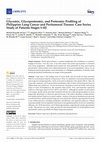
Cancers
Lung cancer is the leading cause of cancer death and non-small cell lung carcinoma (NSCLC) accoun... more Lung cancer is the leading cause of cancer death and non-small cell lung carcinoma (NSCLC) accounting for majority of lung cancers. Thus, it is important to find potential biomarkers, such as glycans and glycoproteins, which can be used as diagnostic tools against NSCLC. Here, the N-glycome, proteome, and N-glycosylation distribution maps of tumor and peritumoral tissues of Filipino lung cancer patients (n = 5) were characterized. We present several case studies with varying stages of cancer development (I−III), mutation status (EGFR, ALK), and biomarker expression based on a three-gene panel (CD133, KRT19, and MUC1). Although the profiles of each patient were unique, specific trends arose that correlated with the role of aberrant glycosylation in cancer progression. Specifically, we observed a general increase in the relative abundance of high-mannose and sialofucosylated N-glycans in tumor samples. Analysis of the glycan distribution per glycosite revealed that these sialofucosyla...
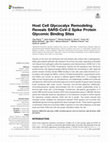
Frontiers in Molecular Biosciences
Glycans on the host cell membrane and viral proteins play critical roles in pathogenesis. Highly ... more Glycans on the host cell membrane and viral proteins play critical roles in pathogenesis. Highly glycosylated epithelial cells represent the primary boundary separating embedded host tissues from pathogens within the respiratory and intestinal tracts. SARS-CoV-2, the causative agent for the COVID-19 pandemic, reaches into the respiratory tract. We found purified human milk oligosaccharides (HMOs) inhibited the viral binding on cells. Spike (S) protein receptor binding domain (RBD) binding to host cells were partly blocked by co-incubation with exogenous HMOs, most by 2-6-sialyl-lactose (6′SL), supporting the notion that HMOs can function as decoys in defense against SARS-Cov2. To investigate the effect of host cell glycocalyx on viral adherence, we metabolically modified and confirmed with glycomic methods the cell surface glycome to enrich specific N-glycan types including those containing sialic acids, fucose, mannose, and terminal galactose. Additionally, Immunofluorescence studi...
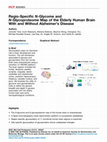
Molecular & Cellular Proteomics
Glycosylation plays an important role in brain development and function. The cell membraneassocia... more Glycosylation plays an important role in brain development and function. The cell membraneassociated N-glycans and glycoproteins from the human brain were characterized using a nanoflow LC-MS/MS platform. The brain regions included the frontal, temporal, parietal, occipital, cingulate, lateral cerebellar and orbitofrontal cortex, posterior hippocampus, thalamus, caudate nucleus, and pons. We illustrate the utility of glycomic and glycoproteomic tools to define the general breadth and depth in glycans associated with the elderly human brain and some neuropathological conditions. Highlights • The N-glycome and N-glycoproteome map of the human brain is characterized. • A liquid chromatography-mass spectrometry platform is successfully established. • Region-specific glycosylation of 11 functional human brain regions is examined. • Site-specific glycosylation of glycoproteins shows widespread changes.
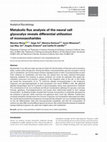
Glycobiology, 2020
Saccharides in our diet are major sources of carbon for the formation of biomass such as proteins... more Saccharides in our diet are major sources of carbon for the formation of biomass such as proteins, lipids, nucleic acids and glycans. Among the dietary monosaccharides, glucose occupies a central role in metabolism, but human blood contains regulated levels of other monosaccharides as well. Their influence on metabolism and how they are utilized have not been explored thoroughly. Applying metabolic flux analysis on glycan synthesis can reveal the pathways that supply glycosylation precursors and provide a snapshot of the metabolic state of the cell. In this study, we traced the incorporation of six 13C uniformly labeled monosaccharides in the N-glycans, O-glycans and glycosphingolipids of both pluripotent and neural NTERA-2 cells. We gathered detailed isotopologue data for hundreds of glycoconjugates using mass spectrometry methods. The contributions of de novo synthesis and direct incorporation pathways for glucose, mannose, fructose, galactose, N-acetylglucosamine and fucose were ...
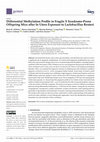
Genes
Environmental factors such as diet, gut microbiota, and infections have proven to have a signific... more Environmental factors such as diet, gut microbiota, and infections have proven to have a significant role in epigenetic modifications. It is known that epigenetic modifications may cause behavioral and neuronal changes observed in neurodevelopmental disabilities, including fragile X syndrome (FXS) and autism (ASD). Probiotics are live microorganisms that provide health benefits when consumed, and in some cases are shown to decrease the chance of developing neurological disorders. Here, we examined the epigenetic outcomes in offspring mice after feeding of a probiotic organism, Lactobacillus reuteri (L. reuteri), to pregnant mother animals. In this study, we tested a cohort of Western diet-fed descendant mice exhibiting a high frequency of behavioral features and lower FMRP protein expression similar to what is observed in FXS in humans (described in a companion manuscript in this same GENES special topic issue). By investigating 17,735 CpG sites spanning the whole mouse genome, we c...
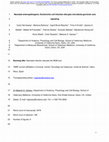
ABSTRACTBackgroundDiarrheal diseases are a leading cause of death in children under age five worl... more ABSTRACTBackgroundDiarrheal diseases are a leading cause of death in children under age five worldwide. Repeated early life exposures to diarrheal pathogens can result in co-morbidities including stunted growth and cognitive deficits suggesting an impairment in the microbiota-gut-brain (MGB) axis.MethodsNeonatal C57BL/6 mice were infected with EPEC (strain e2348/69; ΔescV [T3SS mutant]), or vehicle (LB broth) via orogastric gavage (105 CFU) at post-natal day (P7). Behavior (novel object recognition [NOR] task, light/dark [L/D] box, and open field test [OFT]), intestinal physiology (Ussing chambers), and the microbiota (16S Illumina sequencing) were assessed in adulthood (6-8 weeks).ResultsNeonatal infection of mice with EPEC impaired recognition memory (NOR task), coupled with increased neurogenesis (Ki67 and doublecortin immunostaining) and neuroinflammation (increased microglia activation [Iba1]) in adulthood. Intestinal pathophysiology was characterized by increased secretory sta...
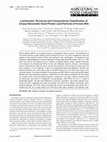
Journal of Agricultural and Food Chemistry, 2010
Milk fat globules (MFGs) are accepted primarily as triacylglycerol delivery systems. The identifi... more Milk fat globules (MFGs) are accepted primarily as triacylglycerol delivery systems. The identification of nanometer-sized lipid-protein particles termed "lactosomes" that do not contain triacylglycerol raises the question of their possible functions. MFGs were isolated by slow centrifugation, and lactosomes were isolated by ultracentrifugation at a density equivalent to plasma high-density lipoproteins (HDL) (d > 1.063 g/mL) from human milk obtained from six volunteers at different lactation stages. Isolated lactosomes were analyzed and compared with MFGs for their size distribution, lipidome, proteome, and functional activity. Lactosomes from early milk, day 8, were found to be similar in size as those from mature milk >28 days, averaging ∼25 nm in diameter. In total, 97 nonredundant proteins were identified in the MFG and lactosome fractions, 46 of which were unique to the MFG fraction and 29 of which were unique to the lactosome fraction. The proteins identified in the lactosome and MFG fractions were enriched with proteins identified with immunomodulatory pathways. Unlike MFGs and GM1-laden reconstituted HDL that served as a positive control, lactosomal binding capacity to cholera toxin was weak. Lipidomic analyses found that lactosomes were devoid of triacylglycerol and gangliosides, unlike MFGs, but rich in a variety of phospholipid species. The data found differences in structure, composition, and function between lactosomes and MFG, suggesting that these two particles are derived from different biosynthetic and/or secretory pathways. The results reveal a bioactive lipid-protein, nanometer-length scale particle that is secreted into milk not to supply energy to the infant but to play unique, protective, and regulatory roles.
International Immunology, 2008
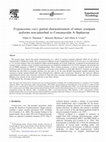
Experimental Parasitology, 2003
The present paper reports the partial characterization of a subset of atypical cruzipain molecule... more The present paper reports the partial characterization of a subset of atypical cruzipain molecules which do not bind to Concanavalin A-Sepharose column. They are present in different strains of epimastigote forms of Trypanosoma cruzi and represent a 2-4% of total cruzipain. They were purified by affinity chromatography on Cystatin-Sepharose, recognized by the polyclonal anticruzipain serum, and their activity in gelatin-containing gels was completely abolished by E-64, TLCK, leupeptin, and aprotinin but not by PMSF, pepstatin A, EDTA or 1,10-phenantroline. These cysteine proteinases, as well as cruzipain showed to be endoproteinases able to hydrolize azocasein, hemoglobin, and bovine serum albumin at acidic pHs. However, evidences are presented indicating that this subset of cruzipain isoforms were also able to use the same blocked chromogenic peptidyl substrates than cruzipain at similar optimal alkaline pH values although with a different order of preference. Moreover, they showed a different oligosaccharide pattern after enzymatic treatment by high pH anion exchange chromatography, suggesting that this structural difference may account for the atypical behaviour in the lectin columm.

Experimental Parasitology, 2002
Plasmatic levels of pregnancy zone protein (PZP) increase in children with acute Chagas disease. ... more Plasmatic levels of pregnancy zone protein (PZP) increase in children with acute Chagas disease. PZP, as well as alpha2-macroglobulin (alpha2-M), are able to interact with Trypanosoma cruzi proteinases. The interaction of alpha2-M and PZP with cruzipain, the major cysteine proteinase of T. cruzi, was investigated. Several molecular changes on both alpha-M inhibitors under reaction with cruzipain were found. PAGE analysis showed: (i) formation of complexes of intermediate mobility and tetramerization of native alpha2-M and PZP, respectively; (ii) limited proteolysis of bait region in alpha2-M and PZP, and (iii) covalent binding of cruzipain to PZP and alpha2-M. Conformational and structural changes experimented by alpha-Ms correlate with modifications of the enzyme electrophoretic mobility and activity. Cruzipain-alpha-M complexes were also detected by gelatin SDS-PAGE and immunoblotting using polyclonal anti-cruzipain antibodies. Concomitantly, alpha2-M and PZP impaired the activity of cruzipain towards Bz-Pro-Phe-Arg-pNA substrate. In addition, alpha-Ms were able to form covalent complexes with membrane isoforms of cysteine proteinases cross-reacting with cruzipain. The present study suggests that both human alpha-macroglobulin inhibitors could prevent or minimize harmful action of cruzipain on host's molecules and hypothetically regulate parasite functions controlled by cruzipain.

Analytical Chemistry, 2011
Given the biological importance of glycosylation on proteins, the identification of protein glyco... more Given the biological importance of glycosylation on proteins, the identification of protein glycosylation sites is integral to understanding broader biological structure and function. Unfortunately, the determination of the microheterogeneity at the site of glycosylation still remains a significant challenge. Nanoflow liquid chromatography with tandem mass spectrometry provides both separation of glycopeptides and the ability to determine glycan composition and site-specific glycosylation. However, because of the size of glycopeptides, they are not often amenable to tandem MS. In this work, proteins are digested with multiple proteases to produce glycopeptides that are of suitable size for tandem MS analysis. The conditions for collision-induced dissociation are optimized to obtain diagnostic ions that maximize glycan and peptide information. The method is applied to glycoproteins with contrasting glycans and multiple sites of glycosylation and identifies multiple glycan compositions at each individual glycosylation site. This method provides an important improvement in the routine determination of glycan microheterogeneity by mass spectrometry.
Molecular & Cellular Proteomics
Brain, Behavior, and Immunity
Infection and Immunity
Diarrheal diseases are a leading cause of death in children under the age of 5 years worldwide. R... more Diarrheal diseases are a leading cause of death in children under the age of 5 years worldwide. Repeated early-life exposures to diarrheal pathogens can result in comorbidities including stunted growth and cognitive deficits, suggesting an impairment in the microbiota-gut-brain (MGB) axis.











Uploads
Papers by Mariana Barboza